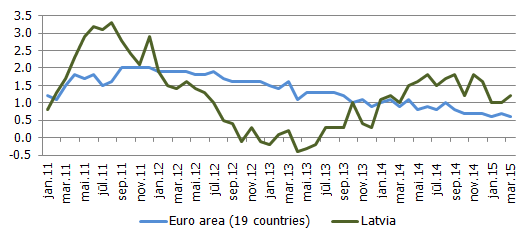Main characteristics of core inflation trends
For Latvijas Banka Monthly Newsletter, In Focus, April
Currently, inflation is at a low level both in the euro area and Latvia. This phenomenon has been widely discussed, though mainly from the economic policy perspective. In fact, it largely stems from the global food and energy price developments that are often supply-side-driven. Core inflation is often thought to be an indicator of an underlying long-term inflation trend stemming from the economic growth and demand side influence. However, at the same time, it lives a slightly different life.
The concept of core inflation is very common; however, its measuring methods vary from quite simple statistical to model-based ones that do not always produce the same results and are not easily interpreted. One of the most often used methods to measure core inflation is to exclude the most volatile components related to global market developments, such as energy and unprocessed food prices. Even though these components tend to be associated with the supply side due to production depending on natural resources, weather and political conditions, the remaining part of inflation is indirectly influenced by the cost-push effects, i.e. higher costs of production and higher costs of raw materials. Therefore, volatility of core inflation may differ across countries. The enclosed Figure presents core inflation developments in Latvia and its average indicators for the 19 euro area countries. The line representing core inflation of Latvia is more volatile as the weights of processed food are higher in the consumption basket, while the processed food prices are still related to the commodity market. The figure shows that Latvia's core inflation is also higher in certain periods (for instance, in 2011 and 2014) due to larger contribution from indirect taxes and the income effect, a common characteristic for a catching-up country.
Figure 1. Y-o-y HICP excluding unprocessed food and energy, %

Source: Eurostat
In Latvia, core inflation picked up gradually in the course of 2013 and continued to grow somewhat in 2014, reflecting resumed economic growth and a moderate increase in average income. Moreover, in 2014, it reflected some euro introduction effects (Eurostat estimated effect is up to 0.2 pp) and an increase in the excise tax on tobacco. In early 2015, core inflation decreased somewhat, reflecting one-off effects of the euro introduction as well as some slowdown of the economic growth. With the cost-push pressure (in terms of commodity prices such as food and energy) largely nonexistent, also the year-on-year pickup in prices of some core components could have decreased. It refers, for instance, to package holiday prices due to lower fuel costs in February.
However, it is also possible that the income redistribution effect has played a role as well. Lower expenditure necessary for food and energy due to prices falling year-on-year and much lower physical consumption of energy because of the warmer winter could have shifted a share of income towards the demand for services or industrial goods. After having decreased to 1% in January-February, core inflation rose to 1.2% year-on-year in March supporting this view. With the economic growth resuming, core inflation in Latvia is also expected to pick up in the medium run.
Textual error
«… …»






